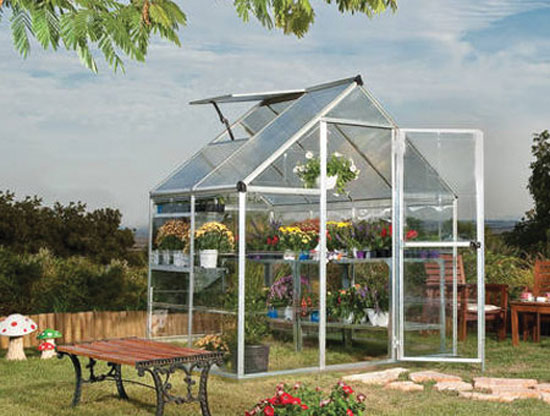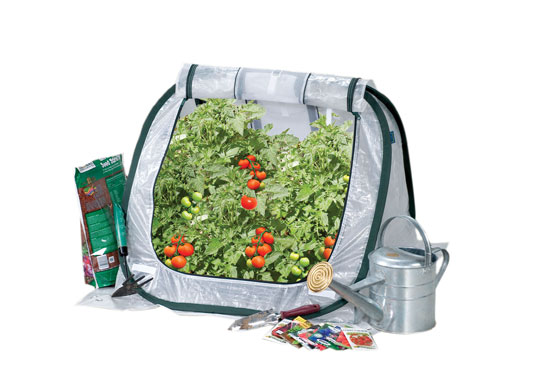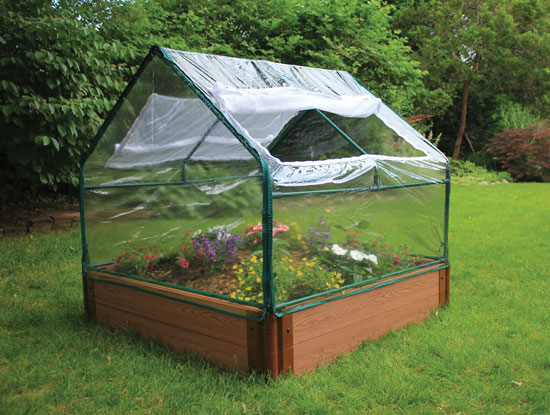Especially in winter, many gardeners dream of having a small greenhouse—a sun-warmed spot where we can get a head start on the spring salad season and start veggie seedlings indoors. But the dream often shatters when money enters the picture—a nicely outfitted greenhouse can cost thousands of dollars. Why not start small with a portable greenhouse you can pop up in early spring and take down and store until it is needed again in the fall? A mini-greenhouse may provide all the growing space you need at a fraction of the cost of a permanent structure. Ranked by price from less than $50 for seasonal pop-up greenhouses to $500 for a permanent hard-sided structure, the five small greenhouses described here demonstrate how easy it can be to expand your growing space for plants in need of protection from cold, wind and curious animals.
Portable Greenhouses for Small Spaces
1. Available at numerous retail stores, the FlowerHouse SeedHouse Jr. pop-up greenhouse costs around $40, and its 30-inch square footprint makes it easy to fit in small spaces such as a condo balcony. A pair of zippered doors on either side of the opaque plastic A-frame structure allows easy access, and during the day you can keep the screened vents open to ensure good air circulation. The sloping sides of the SeedHouse Jr. limit the growing space available to tall plants, but it easily accommodates 35 compact plants grown in 4-inch pots—plenty of plants for a square-foot garden or your community garden plot.
2. At around $100, the larger FlowerHouse PlantHouse 4 is as portable as the SeedHouse Jr., but with a much roomier interior. Inside dimensions of this pop-up greenhouse measure 4-by-4 feet, with peak height at 54 inches—plenty of space for several flats of seedlings or dozens of plants in 4-inch pots. In mild winter climates, the PlantHouse 4 can provide winter protection for figs and other marginally hardy plants. Used as a seasonal greenhouse, the PlantHouse 4 is perfect for tall, late spring tomatoes when it’s still too early to set them out, or to protect summer tomatoes from excessive rain.
3. If your garden could use raised beds and a small greenhouse, the Frame-It-All raised bed with greenhouse is a kit to consider. Priced at around $130, the kit includes a 4-by-4-foot raised bed with attachable frame. The frame legs slip into the bed’s corner connectors, which are topped with a zip-on cover. Large zip-open side doors allow easy access to plants, with smaller vents on opposing sides. If you already have raised beds, you can add the greenhouse frame and cover for about $70. Many people let the greenhouse frame stay in the garden all season, where it can be used to support row covers to protect plants from insects.
Walk-In Small Greenhouses
1. If you dream of a sun-warmed greenhouse where you will be surrounded by growing plants, the 6-by-8-foot GrowIt Organic Growers Greenhouse from ShelterLogic can complete the picture for just more than $200. Although the entire kit weighs less than 65 pounds, the frame for this small greenhouse is made of steel, and the covering is a high-density ripstop polyethylene fabric with vents near the ground as well as up high, above the doors. Auger-type anchors help hold the structure steady in the wind, or you can attach the base to a wood frame. Trimmed in forest green, the GrowIt Organic Growers Greenhouse looks more like fabric than plastic, and there is space for shelves along the sides and a chair where you can join your plants in soaking up some solar heat.
2. When you are ready for a permanent small greenhouse that can stand up to heavy rains and snows, the Brighton Hybrid Greenhouses offer many advantages for $350 to $600, depending on size and accessories. A steel base frame anchors the structure, and the rest of the frame is lightweight aluminum. The “hybrid” aspect has to do with the polycarbonate panels, which are clear on the sides and opaque on the roof, maximizing light to plants while reducing the risk of getting fried. An optional automatic vent opener can cut this risk to near zero. A 6-by-4-foot model in silver costs $350, and the Idaho company offers free shipping and no sales tax. Models with the frame finished in pretty forest green cost slightly more, but become an instant focal point in the landscape.
Buying a Small Greenhouse: 5 Questions to Ask
Before considering the possibilities, think about how a mini greenhouse will fit into your landscape and earn its keep by helping you grow a better garden. You might start with these five questions.
1. When do you need greenhouse space?
Most veggie gardeners yearn for protected space for seedlings for eight to 10 weeks in spring. Onions, cabbage and other cold-tolerant crops can be moved to an unheated mini-greenhouse about six weeks before the last spring frost is expected, with frilly lettuces not far behind. After these and other cool-season veggies are planted out, the greenhouse can be used to prepare warm-natured tomatoes, peppers and eggplants for life in the garden. In late summer and fall, a small greenhouse makes an ideal place to cure winter squash or sweet potatoes, to extend the harvest season for tender veggies, or to hide leafy greens from deer.
2. Will you use your greenhouse in winter in a snowy climate?
Greenhouses that consist of plastic covers supported by wire hoops will not hold up to heavy snow loads. Indeed, the best structures for winter gardening in cold climates are not greenhouses at all, but rather ground-hugging frames and tunnels.
3. How many plants will you grow in your greenhouse?
To answer this question, think about how many seedling flats you are likely to have growing at the same time. The plastic flats used in nurseries measure 11-by-21 inches, so six flats fit easily into a 4-by-4-foot mini-greenhouse. Height can be important, too. Tomatoes held in containers until they are knee-high need more head space than low-growing onion seedlings.
4. Is a good site available?
Like other structures, greenhouses of any size work best when erected on a level site. Where space is tight, you can use a portable pop-up greenhouse on a deck or patio.
5. Are high winds likely to affect your greenhouse?
Plastics and wind are natural enemies, so it is crucial that you be able to securely anchor any type of greenhouse structure. In windy sites, the best spot for a greenhouse may be snuggled against the south side of your house.
Heating a Mini-Greenhouse
Large greenhouses often use tanks of water to provide steady warmth, but there is little room for water reservoirs in a portable greenhouse. Instead, try these tricks for heating a mini-greenhouse on cold nights.
• A string of white lights arranged on the floor of a pop-up greenhouse, between pots or trays, will help keep roots warm on cold nights.
• A slow cooker filled halfway with water and turned on low, with the lid on, will generate steady humid heat in a small greenhouse with no risk of fire.
•Bales of hay placed against the north side of the structure will provide insulation and generate a little heat.









